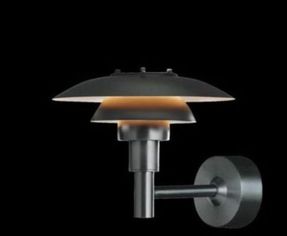Louis Poulsen PH 3-2½ Wall Light
PH 3-2½ WALL LIGHT
PH 3-2½ WALL LIGHT
Designed by Poul Henningsen
The fixture is designed based on the principle of a reflective three-shade system, which directs the light downwards. The shades have a matt white painted interior surface, diffusing the light in a comfortable way.
DESIGNER
POUL HENNINGSEN
Poul Henningsen was born in Copenhagen by the famous Danish writer Agnes Henningsen. He never graduated as an architect, but studied at The Technical School at Frederiksberg, Denmark from 1911-14, and then at Technical College in Copenhagen from 1914-17.
He started practicing traditional functionalistic architecture, but over the years his professional interests changed to focus mainly on lighting which is what he is most famous for.
He also expanded his field of occupation into areas of writing, becoming a journalist and an author. For a short period at the beginning of WWII, he was the head architect of the Tivoli Gardens in Copenhagen.
But like many other creative people, he was forced to flee Denmark during the German occupation but soon became a vital part of the Danish colony of artists living in Sweden.
His lifelong collaboration with Louis Poulsen began in 1925 and lasted until his death. To this day, Louis Poulsen still benefits from his genius. Poul Henningsen was also the first editor of the company magazine “NYT”.
The CEO of Louis Poulsen at the time, Sophus Kaastrup-Olsen, gave the magazine to PH as a gift because he had been terminated from the Danish newspaper he worked for (his opinions were too radical).
Poul Henningsen's pioneering work concerning the relations between light structures, shadows, glare, and color reproduction—compared to man’s need for light remains the fondation of the lighting theories still practiced by Louis Poulsen.
INFORMATION
BRAND
Louis Poulsen
PRODUCT TYPE
Wall Light
CLASS
Ingress protection IP44. Electric shock protection I w. ground.
MOUNTING
Terminal block: 1x3x2.5mm². Cable entries: 2x bottom + 3x rear entries for Ø 10-14.5mm cable. Looping: Approved, max. 3x1,5mm².
MATERIALS
- Top shade: Spun stainless steel.
- Middle & lower shade: Spun stainless steel.
- Shadeholder: Form pressed glass.
- Wall box: Die cast aluminium.
- Wall box cover: Spun aluminium.
- Arm: Stainless steel.
LIGHT DESCRIPTION
The fixture emits symmetrical light directed downwards.
DESIGNER
Poul Henningsen
SPECIFICATION NOTES
The innovation of light sources is ongoing. Consequently we only inform about the max. wattages. On www.louispoulsen.com we update a list of recommendable light sources.
HISTORY
THE STORY BEHIND THE PRODUCT
Poul Henningsen designed the three-shade system back in 1925-1926. The first lights using the system were designed by PH in cooperation with Louis Poulsen for an exhibition in Paris. This partnership continued up until his death in 1967. Throughout his life, PH sought to create glare-free light, direct light where it was most needed, and create soft shadows, using incandescent bulbs as a light source. PH 3/2½ Wall is a member of the three-shade family which numbers 30 lights today, including three for outdoor use.
Thus PH did not just design a light, but an entire system – around a thousand different models have been produced over the years. This wide selection consisted of table, floor and wall lamps, as well as a number of different chandeliers, which were very popular in the 30s for lighting private homes from high ceilings.
There were countless combination options. The lights were available in different colours, as well as a range of sizes. The first shades were made of metal with a painted undersurface, such as white, gold or silver – depending on whether diffuse, warm or cold light was desired. Glass was later introduced for the three-shade system.
In addition to the downward-directed light, glass lamps illuminated the room. PH was the first person to pursue a scientific approach to light and use the logarithmic spiral as a basis. By using a design based on the logarithmic spiral he achieved even distribution of light over the entire curve of the shade.
This even light distribution, together with the diffuse reflection through the glass, made it possible to control glare and shadow. Each shade reduces the amount of light equally, due to their distance from the light source. The PH light model numbers refer to the shade size. Each top shade had a corresponding set of middle and lower shades.
In the ‘pure’ models, such as the 2/2, the top shade has a size of about 20 cm, with corresponding lower shades. PH 3/2½ Wall consists of an approximately 30 cm top shade, but uses lower shades from the 2½ model. These ‘hybrid’ models were introduced due to the desire to hang pendants at lower heights. The system was also used for wall, floor and table lamps. PH 3/2½ Wall was introduced in 2005.




